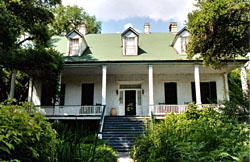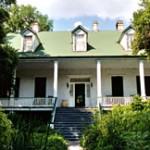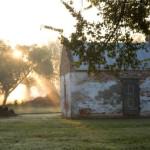NATCHITOCHES, LA -National Parks are here to tell the story of our country, and Cane River Creole National Historical Park is one of many parks dedicated to interpreting the African American experience. The park's Oakland and Magnolia Plantations were home to individuals and families of African descent who proved to be valuable members of the plantation community.
One of these individuals was Agnes Wade of Magnolia Plantation. Evidence suggests that Agnes and her family moved to Magnolia in 1885, where she would serve as the plantation's midwife for the next thirty years until her death in 1922 at the age 119. As a plantation midwife Agnes would have assisted other women with childbirth. Agnes also more than likely served as a doctor or healer. According to historian Deborah Gray White, a midwife like Agnes would have ‘…embodied the link between generations. And, it was partly through them that a central aspect of black culture,the secret of the herbs,was transmitted.’ Due to her knowledge of medicine and childbirth, Agnes would have been a very prominent individual in the Magnolia Quarters community.
Solomon Williams, an enslaved blacksmith on Oakland Plantation, was an equally prominent individual in his community. Men like Williams were viewed as important figures by their peers and also by the slave-owners. A good blacksmith was essential to the plantation operation, thus increasing his value to the plantation owner. Among his peers, Williams was likely seen as a community leader and possibly even a religious practitioner. Williams left behind a legacy of ironwork, including elaborate grave markers.
During Black History Month we tend to focus on the contributions of iconic figures like Martin Luther King, Jackie Robinson, and Harriet Tubman, but we should also acknowledge people like Solomon Williams and Agnes Wade. Wade and Williams are not household names, but they were leaders in their communities who formed their own identities and methods of self-expression during times of racial oppression.
To learn more about Agnes Wade and Solomon Williams visit their former homes at Cane River Creole National Historical Park's Oakland and Magnolia Plantation.
Cane River Creole NHP's Oakland and Magnolia Plantations are open seven days a week from 8am-4pm except on Thanksgiving, Christmas, and New Year's Day. To reach Oakland Plantation, take I-49 to Exit 127, Flora/Cypress. Head east on LA Highway 120 toward Cypress. Once you reach the LA Highway 1 intersection cross over LA Highway 1 onto LA Highway 494. The parking lot and entrance pavilion for Oakland are 4.5 miles east of Highway 1 on the left.
For more information contact Nathan Hatfield, 318-356-8441 Nathan_Hatfield@nps.gov.



